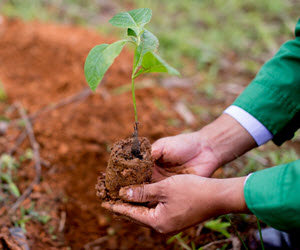I recently became a home gardener.
After spending weeks researching the most efficient way to build a raised bed, as well as carefully selecting the source of my soil, seeds, plants, and other needed materials, I set out on this entirely unknown world of growing and sustaining life in my backyard. I started composting, I learned about pH levels in soil, I learned about odd insects and fungi that can infect your innocent little plants for no good reason. I also learned the joy of progress – how amazing it is to watch something you sowed in the ground in the form of a nearly invisible seed sprout forth and grow into a beautiful, vibrant plant. The things I’ve seen and experienced in a few short months of gardening have given me numerous insights into nature’s way. Most significantly, though, I have seen the lens of grief anew in the cycle of life and death as observed in the garden.
 “The seed must die for the plant to grow.”
“The seed must die for the plant to grow.”
These words were uttered to me in my earliest conversation with my would-be-garden-mentor, the first time I ever sought advice on how to sustain my little seedlings in this newly created environment. It was an idea I had somehow never considered. The process that occurs in gardening is just this – a seed is planted, and in order for life to grow from it, it must die. The life breaks free from the seed and sprouts into something new, leaving behind the shell of what once contained it.
The new life that is created from the death of the seed is exciting and vibrant, and (if successful), it produces fruit. You harvest the fruit – removing it from its source to be consumed – and watch as more is produced. All of this is very exciting, but there comes an end to every harvest. These seasonal occurrences were not dreamed up by any man; they are embedded into the natural rhythm of life. The seed must die for the plant to grow.
During my meaningful moments with grief support groups, we have processed these metaphors. The natural processes of life and death contain hidden gems of value for those walking the grief journey. In our most ponderous moments, we have wondered how we, as the ones grieving, can create the most rich environment in our lives now to promote growth after the loss of a loved one. What proverbial fertilizer, or water, or sunlight, can one apply for one’s own growth and wellbeing in times of loss? Additionally, what fruit is being produced right now, in this very moment of pain? Oftentimes, the richest yields come from the most storm-laden seasons.
A few months ago, I noticed my plants respond immediately to large amounts of rain. At first I thought this might mean I wasn’t providing them with enough water. After inquiring, though, I learned the atmosphere during a storm is rich in nitrogen, an element the plants long for, and this is what they respond to as they continue to ascend from the ground. I wonder what elements of growth the storms in your life are holding for you in this moment.
Whatever season you find yourself in, whether it be a time of deficiency or a harvest of abundance, I would ask you to consider the natural cycle of life that comes from loss. Certainly, no one rejoices that this is nature’s way. Loss is hard. Death is painful. And the loss/death in your life might not be of a loved one, but of a season, a relationship, a job, or a dream. Grief can look like losing your spouse or moving to a new city. It takes on many different shapes and it does not discriminate in its victims. To be human is to grieve.
Observing the garden, however, it is clear that sometimes (and I would say oftentimes) death begets life. We cannot change the way of nature, but we can choose to live in a way that works harmoniously with it. I invite you to consider what that looks like in your own life today.
